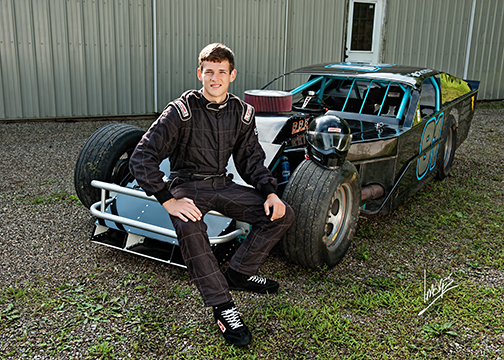During the week, Daniel McPherson is a first-year music education major who runs track and cross-country. But on the weekends, McPherson leaves college life behind for the racetrack.
“I race an Asphalt Modified, which is pretty much a full-sized race car, similar to what you would kind of see in the ranks of NASCAR, except, hence the name, it’s modified,” McPherson said about his vehicle. He races at Shady Bowl Speedway in De Graff, Ohio.
McPherson has been racing full-sized cars at his local racetrack since he was 15-years-old, and was racing smaller “quarter midget” vehicles even before then. “I still remember the day of my first race,” McPherson said. “I was terrified. I remember before the race started I ate an entire box of Cheez-Its out of fear … I’ve definitely come a long way.”

Racing is somewhat of a family hobby for McPherson. His older brother also competes in the same vehicle class as him.
“Between me and my brother, we’re pretty much the youngest drivers in the field,” McPherson said. “A lot of the people racing are in their 30s or 40s, or 50s.” McPherson’s father also used to race, and currently acts as his mechanic. “The real brains behind what our cars are doing is all thanks to my dad. The stuff he does is amazing,” McPherson said.
According to McPherson, racing is a difficult and expensive sport to get into.
“It depends on who you know … if you know somebody who owns a [race] car, they might be like ‘hey, do you want to drive my car?’”
McPherson said that modified cars like the one he drives are not street legal and can’t easily be purchased. Instead, they need to either be custom built from scratch or commissioned from a specialized garage.
While there are sometimes winnings from a race, McPherson stated that it is very difficult to break even when considering maintenance costs and pit entry fees.
“In the more advanced classes, it is a lot more difficult, a lot more expensive,” McPherson said.

The typical race McPherson participates in is 30 laps on an asphalt track that’s about three-tenths of a mile long, which according to McPherson is relatively small as far as racetracks go. “In the class that I’m in, we typically have between 16 and 20 cars, on average,” McPherson said.
Several different things go through McPherson’s head when he’s driving.
“When you’re inside the car, it’s amazing how much slower it feels like time is going.” McPherson pays a lot of attention to how much pressure he’s putting on the gas pedal and when he needs to break for curves in the track. The vehicles used in the races also don’t have mirrors, so McPherson also has to listen for the other cars as they try to pass him.
“It’s so cool,” McPherson said about his racing experiences. “The feeling you get when you’re going 100 miles an hour, in a tight circle, with all these cars going around you, all trying to win, it really is an adrenaline rush. There’s not many things you can do in life that give you the same feeling.”
McPherson stated that he’s never been severely injured racing.
“One time a rock flew up and it hit me in the hand,” McPherson recalled. “I thought it broke my finger at first, but I ended up being fine.” Overall McPherson indicated that he has seen very few injuries in his time racing. “Racing is one of the safer sports you can do,” he said.
Despite his passion for it, McPherson described racing as more of a hobby for him. His long-term plan is to focus on his studies and make connections at the university in order to fulfill his current goal of becoming a high school band director.
Still, when it does come to racing, McPherson encouraged people to give local racing a try.
“If you’ve never been to a race before, I highly recommend that like, everybody out there tries it out,” he said. “It really is exciting … if there’s a local track near you, whether it’s dirt or asphalt, if you’ve never been, check it out.”
